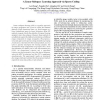Free Online Productivity Tools
i2Speak
i2Symbol
i2OCR
iTex2Img
iWeb2Print
iWeb2Shot
i2Type
iPdf2Split
iPdf2Merge
i2Bopomofo
i2Arabic
i2Style
i2Image
i2PDF
iLatex2Rtf
Sci2ools
ICCV
2011
IEEE
2011
IEEE
A Linear Subspace Learning Approach via Sparse Coding
Linear subspace learning (LSL) is a popular approach to image recognition and it aims to reveal the essential features of high dimensional data, e.g., facial images, in a lower dimensional space by linear projection. Most LSL methods compute directly the statistics of original training samples to learn the subspace. However, these methods do not effectively exploit the different contributions of different image components to image recognition. We propose a novel LSL approach by sparse coding and feature grouping. A dictionary is learned from the training dataset, and it is used to sparsely decompose the training samples. The decomposed image components are grouped into a more discriminative part (MDP) and a less discriminative part (LDP). An unsupervised criterion and a supervised criterion are then proposed to learn the desired subspace, where the MDP is preserved and the LDP is suppressed simultaneously. The experimental results on benchmark face image databases validated that the p...
Related Content
| Added | 11 Dec 2011 |
| Updated | 11 Dec 2011 |
| Type | Journal |
| Year | 2011 |
| Where | ICCV |
| Authors | Lei Zhang, Pengfei Zhu, Qinghu Hu, David Zhang |
Comments (0)

